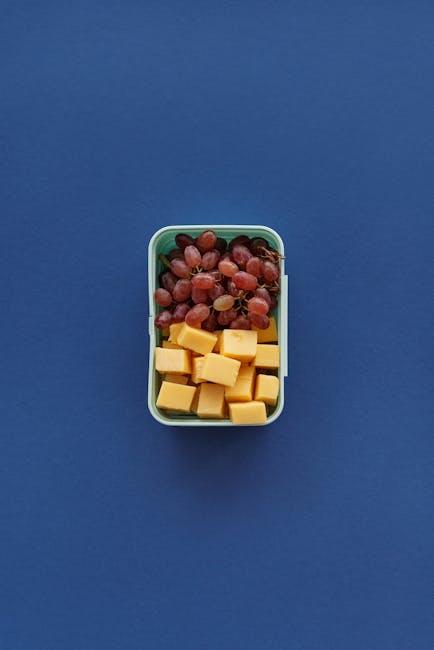In the hustle and bustle of modern life, the quest for convenience often leads us down a path of fast food and fleeting nutrition. Yet, nestled within the chaos is a simple solution that promises to transform our eating habits and, ultimately, our well-being: meal prepping. Imagine opening your refrigerator to find a week’s worth of delicious, nutritious meals ready to go, crafted by none other than you. This isn’t just a fantasy—it’s an achievable reality. In this article, we will explore easy meal prepping tips that not only save time and money but also pave the way for long-term health benefits. Whether you’re a seasoned chef or a kitchen novice, these strategies will help you navigate the art of meal prepping with ease, turning your culinary aspirations into sustainable habits. Join us as we embark on a journey to make meal prepping an effortless part of your lifestyle, ensuring that every meal is a step towards a healthier you.
Streamline Your Grocery Shopping for Efficiency
Transform your grocery shopping into a streamlined process by organizing your list according to store layout and weekly meal plans. Begin by grouping items by category such as produce, dairy, meats, and grains. This method minimizes backtracking in the store, saving you both time and energy. Additionally, plan your meals around versatile ingredients that can be used in multiple dishes. For instance, a roasted chicken can serve as a main course one day, and its leftovers can be repurposed into salads or sandwiches for the rest of the week.
- Opt for pre-chopped vegetables to cut down on prep time.
- Choose frozen fruits and vegetables for long-lasting freshness and convenience.
- Invest in bulk grains and proteins to reduce packaging waste and shopping frequency.
- Utilize apps or digital lists to keep track of your pantry and avoid duplicate purchases.
With these strategies, not only will you make your shopping trips more efficient, but you’ll also foster a more organized kitchen and reduce food waste. The key is consistency—over time, these habits will become second nature, leading to a more seamless and stress-free cooking experience.

Mastering Portion Control for Balanced Meals
Understanding how to manage your meal portions is crucial for maintaining a balanced diet. It’s not just about cutting calories; it’s about ensuring you’re getting the right nutrients in the right amounts. Here are some practical tips to help you achieve this:
- Use smaller plates and bowls: This simple trick can help you feel satisfied with less food, preventing overeating.
- Balance your plate: Fill half of your plate with vegetables, a quarter with protein, and the remaining quarter with whole grains. This method ensures a nutritious and satisfying meal.
- Measure your food: Investing in a kitchen scale or using measuring cups can help you accurately portion out servings, especially when prepping meals for the week.
By integrating these techniques into your daily routine, you can enjoy delicious meals without the worry of overindulging. Consistent practice of portion control not only supports weight management but also encourages a healthier relationship with food.

Time-Saving Cooking Techniques for Busy Schedules
Maximize your culinary efficiency by adopting smart strategies that fit seamlessly into your hectic lifestyle. Batch cooking is a game-changer, allowing you to prepare multiple meals at once and store them for later. Choose versatile ingredients that can be used in various recipes, like grilled chicken or roasted vegetables. This approach not only saves time but also ensures you have healthy options readily available.
- Pre-chop Ingredients: Spend a few minutes after your grocery run to chop veggies or marinate proteins. Store them in airtight containers for quick access.
- Use One-Pot Recipes: Opt for meals that require minimal cleanup, like stir-fries or soups, which can be cooked in a single pan or pot.
- Freeze in Portions: Divide large batches into single servings before freezing. This makes defrosting easy and reduces food waste.
- Invest in Time-Saving Gadgets: Tools like slow cookers or pressure cookers can significantly cut down cooking time, allowing you to focus on other tasks.
By incorporating these techniques, you can enjoy nutritious, homemade meals without spending hours in the kitchen. Streamlining your cooking process not only saves precious time but also brings a sense of order and simplicity to your daily routine.
Storing and Reheating Tips for Optimal Freshness
Maintaining the quality of your prepped meals is essential for enjoying them at their best. To ensure your meals remain fresh, start by storing them in airtight containers. This helps to prevent moisture loss and protect flavors. Glass containers are ideal for their non-reactive properties, while BPA-free plastic options offer a lightweight alternative. Label each container with the date to easily track freshness.
- Use stackable containers to save space in your fridge or freezer.
- Consider portioning meals into individual servings for convenience.
- Freeze items that won’t be consumed within a few days to extend shelf life.
When it comes to reheating, consistency is key. Microwave settings can vary, so stirring halfway through can help heat your meal evenly. For dishes that benefit from a crispy texture, like roasted vegetables, opt for reheating in the oven or air fryer. Always ensure your meals reach an internal temperature of 165°F (74°C) for safety. By following these steps, your prepped meals will taste just as delicious as the day they were made.

